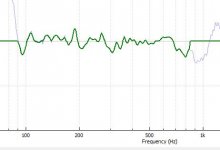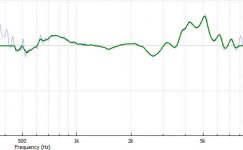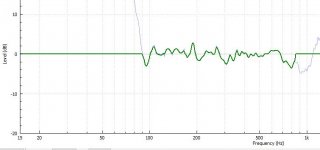I missed something thinking those REW measurements being acoustic measurement from your system.
They are acoustic measurements.....
Sorry, Where have i confused things ?
The processor curves I posted are the EQ and xovers applied, that are producing the acoustic system measurement via REW
Last edited:
Four Audio | PPA-Serie
0:30-1:14min (some might say little bit heresy)
It sure is todays speaker desings with these active processors.
no matter what driver you use you can get flat response
0:30-1:14min (some might say little bit heresy)
It sure is todays speaker desings with these active processors.
no matter what driver you use you can get flat response
Last edited:
650-6300hz
what was drivers again?
That linea processor looks decent
That driver is the lower freq section of the BMS4594.
The Four-Audio stuff looks very good..especially the HD2..albeit very expensive and the Monkey Forrest software looks like "just shoot me" difficult !
And yes, wholeheartedly agree.....it's absolutely amazing how easy it is to achieve flat response with today's processing.

Remembering that four audio i understand why its hard to show any eq stuff
I've using lake for three years now.
Im using fir too, i have couple iir crossovers too but my head it used to this.
There is lots of boost but my vented horn bass can handle as much my socket pops an fuse.
Light home use, 1 watt is usually too much with 108db/w midrange
Lake is truly nice gear, isn't it. Good for you.
I hope you don't have as much trouble understanding the Lake logic/manual as I do, haha.
Oh, the EQ/xover curves for the MID and HF sections that I posted earlier don't go into the Linea.
They go into miniDSP openDRCs.
The Linea doesn't allow user built FIR files to be imported yet, although new firmware for that may be on the horizon.
It just has linear-phase LR24 equivalents that work like any other IIR x-over in a processor.
That's what made the thread opening impulse response comparison so easy.
I hope you don't have as much trouble understanding the Lake logic/manual as I do, haha.
Oh, the EQ/xover curves for the MID and HF sections that I posted earlier don't go into the Linea.
They go into miniDSP openDRCs.
The Linea doesn't allow user built FIR files to be imported yet, although new firmware for that may be on the horizon.
It just has linear-phase LR24 equivalents that work like any other IIR x-over in a processor.
That's what made the thread opening impulse response comparison so easy.
Hi Mark
This is indeed the place where FIR excels. And your step response looks very nice. This is IMO more important than the pulse response because the latter's validity is biased towards the higher frequency contents. Even some speakers which are far from phase-linear show very nice pulse responses.
If one is looking at the crossover function alone one can easily achieve perfect impulse and step-respones using IIR. And IIR is more efficient regarding computing power. The driver rolloff can also be taken into consideration with reasonable effort. But that fine passband equalisation would be a PITA with IIR.
Regards
Charles
IMO, one of the major benefits of FIR is the ability to embed nearly infinite IIR EQs into the FIR file for minimum phase driver correction prior to xover.....so we can have EQ curves as precise and matching as these examples.
This is indeed the place where FIR excels. And your step response looks very nice. This is IMO more important than the pulse response because the latter's validity is biased towards the higher frequency contents. Even some speakers which are far from phase-linear show very nice pulse responses.
If one is looking at the crossover function alone one can easily achieve perfect impulse and step-respones using IIR. And IIR is more efficient regarding computing power. The driver rolloff can also be taken into consideration with reasonable effort. But that fine passband equalisation would be a PITA with IIR.
Regards
Charles
Thanks Charles,
Yes, embedding IIR filters is so dang comparitvely easy.
Lately, I've been using FirDesigner software to auto EQ driver by driver.
Below are the EQ curves for the mid and HF sections I posted earlier, that also had xovers in play. (but this time without xover in play)
How on earth could you ever EQ like that with FIR ? Maybe you can ????
(Manninen, this is what i think you were asking to see...I realized that a different tab in FirDesigner could display EQ alone.)
I see why you like step, due to the high freq bias in impulse.
Can you show how to achieve perfect impulse and step-response using IIR for xover alone? Particularly down low?
I've yet to figure out how to do that......maybe because I only began learning speaker tuning about 3 years ago, and have been using FIR and linear-phase xovers from the start.
Everything else seems so damn complicated lol
Yes, embedding IIR filters is so dang comparitvely easy.
Lately, I've been using FirDesigner software to auto EQ driver by driver.
Below are the EQ curves for the mid and HF sections I posted earlier, that also had xovers in play. (but this time without xover in play)
How on earth could you ever EQ like that with FIR ? Maybe you can ????
(Manninen, this is what i think you were asking to see...I realized that a different tab in FirDesigner could display EQ alone.)
I see why you like step, due to the high freq bias in impulse.
Can you show how to achieve perfect impulse and step-response using IIR for xover alone? Particularly down low?
I've yet to figure out how to do that......maybe because I only began learning speaker tuning about 3 years ago, and have been using FIR and linear-phase xovers from the start.
Everything else seems so damn complicated lol
Attachments
Last edited:
Can you show how to achieve perfect impulse and step-response using IIR for xover alone? Particularly down low?


harsch topology aint perfect but gives decent step, even in brutal car acoustic
Yes, the Harsch crossover is one kind of time-aligned crossover that gives transient-improved results.
Regarding transient-perfect crossovers with IIR two possible topologies pop up:
1.) IIR allpass crossovers (like LR 4) with time-reversed allpass correction.
2.) Subtractive delay as proposed by Lipshitz and Vanderkooy. I once tried this with AD Sigma Studio and the bare crossover alone is a matter of less than 5 minutes to set up (although I had to fight with a bug back then). Unfortunately all DSPs by themselves could theoretically do this without problems but not all of the accompanying GUIs of the easily available turnkey solutions can help to set it up, since one needs to be able to subtract. What I haven't tried so far is this principle with the lowpass filter followed by a group-delay EQ.
Regards
Charles
Regarding transient-perfect crossovers with IIR two possible topologies pop up:
1.) IIR allpass crossovers (like LR 4) with time-reversed allpass correction.
2.) Subtractive delay as proposed by Lipshitz and Vanderkooy. I once tried this with AD Sigma Studio and the bare crossover alone is a matter of less than 5 minutes to set up (although I had to fight with a bug back then). Unfortunately all DSPs by themselves could theoretically do this without problems but not all of the accompanying GUIs of the easily available turnkey solutions can help to set it up, since one needs to be able to subtract. What I haven't tried so far is this principle with the lowpass filter followed by a group-delay EQ.
Regards
Charles
Hi,
Thanks to Jean Michel Le Cleac'h (rip) there is a whole movement of 'quasi optimal' filtering (iir and delay) who developped in french's diy community.
Here is some example of them you could try Mark,
filtre "quasi-optimal" : modeles et variantes - Le blog de jimbee
It is in french but easily translated or self explanatory enough.
Thanks to Jean Michel Le Cleac'h (rip) there is a whole movement of 'quasi optimal' filtering (iir and delay) who developped in french's diy community.
Here is some example of them you could try Mark,
filtre "quasi-optimal" : modeles et variantes - Le blog de jimbee
It is in french but easily translated or self explanatory enough.
Thanks krivium !
That looks like exactly the kind of info I've been looking for.
A lot to digest in there....
But it sure looks like complicated stuff when compared to simple linear-phase..
I'm thinking I might start a thread asking how do we actually discern when pre-ringing is present....... and more importantly, audible....
Because if pre-ringing isn't the problem some make it out to be, especially in comparison to the easily heard improvements in transient response and definition linear-phase brings, well ...
I'm not going to look past using linear-phase xovers other than when latency is an issue.....
Maybe I just need to learn how to hear pre-ringing ???
That looks like exactly the kind of info I've been looking for.
A lot to digest in there....
But it sure looks like complicated stuff when compared to simple linear-phase..
I'm thinking I might start a thread asking how do we actually discern when pre-ringing is present....... and more importantly, audible....
Because if pre-ringing isn't the problem some make it out to be, especially in comparison to the easily heard improvements in transient response and definition linear-phase brings, well ...
I'm not going to look past using linear-phase xovers other than when latency is an issue.....
Maybe I just need to learn how to hear pre-ringing ???
Thanks krivium !
That looks like exactly the kind of info I've been looking for.
A lot to digest in there....
But it sure looks like complicated stuff when compared to simple linear-phase..
I'm thinking I might start a thread asking how do we actually discern when pre-ringing is present....... and more importantly, audible....
Because if pre-ringing isn't the problem some make it out to be, especially in comparison to the easily heard improvements in transient response and definition linear-phase brings, well ...
I'm not going to look past using linear-phase xovers other than when latency is an issue.....
Maybe I just need to learn how to hear pre-ringing ???
The audibility of pre-ringing will depend greatly on the type of music you listen to. If you want to hear it, try something with fast transients like a close-miced piano or drum set, or pizzicato strings. With bowed string instruments, or singing, pre-ringing wont be discernible unless it's drastic. If you follow any of the noise reduction algorithm developments, you'll see that pre-ringing can certainly be a problem there. It's much preferable to ring after something loud happens than before.
It may be possible for you to develop your filters so that the result is a minimum phase response for the bandwidth of the entire system as a whole, rather than a linear response for the system.
I m a believer in fir especially for xover purpose Mark, but as you noted once you want to filter below 1khz it start to be some issue if you do real time events (live or studio: once 3ms latency is reached musicians start complaining in my experience).
One of the solution i ve done is to use Jmlc filter proposition in the low end then use fir higher up ( not really different from bbuterfield proposition).
I don t know if this is possible for you to do such things and beside the fact you can t do what you want with the filters this is what decided me (as well as the eq quality and power) to invest in a Lake dlp as it is easy to perform such task.
Now i ask myself if i won t purchase a digital drc from minidsp to increase the power of the whole solution ( to put it befoe the lake in the digital chain).
Results in the low end are totally acceptable imho with iir quasi transient solution (minimum phase).
One of the solution i ve done is to use Jmlc filter proposition in the low end then use fir higher up ( not really different from bbuterfield proposition).
I don t know if this is possible for you to do such things and beside the fact you can t do what you want with the filters this is what decided me (as well as the eq quality and power) to invest in a Lake dlp as it is easy to perform such task.
Now i ask myself if i won t purchase a digital drc from minidsp to increase the power of the whole solution ( to put it befoe the lake in the digital chain).
Results in the low end are totally acceptable imho with iir quasi transient solution (minimum phase).
The audibility of pre-ringing will depend greatly on the type of music you listen to. If you want to hear it, try something with fast transients like a close-miced piano or drum set, or pizzicato strings. With bowed string instruments, or singing, pre-ringing wont be discernible unless it's drastic. If you follow any of the noise reduction algorithm developments, you'll see that pre-ringing can certainly be a problem there. It's much preferable to ring after something loud happens than before.
It may be possible for you to develop your filters so that the result is a minimum phase response for the bandwidth of the entire system as a whole, rather than a linear response for the system.
Hi, and thanks,
Yes, that is the type of music I try to hear pre-ringing . Maybe I'm just deaf, but so far i can't say i hear any.
No, I haven't studied anything about noise reduction, but I've tried to study the pre and post signal windows of audibility...papers like this for example
http://www.bodziosoftware.com.au/LP_MP_Subwoofer_Tests.pdf
I can clearly see the need to tune to minimum phase down low, for latency purposes...and surely for audible purpose when and if I start to hear pre-ringing
Before you try, find out about unlearning, I focus on unlearning and limiting exposure (to many things) still, doesn't sound good- pre-ringing, "the bells the bells"Maybe I just need to learn how to hear pre-ringing ???
- Status
- This old topic is closed. If you want to reopen this topic, contact a moderator using the "Report Post" button.
- Home
- Loudspeakers
- Multi-Way
- Why passive is passe ;)



